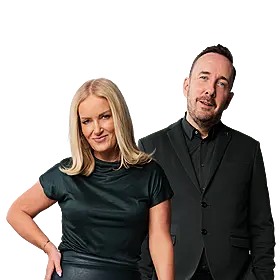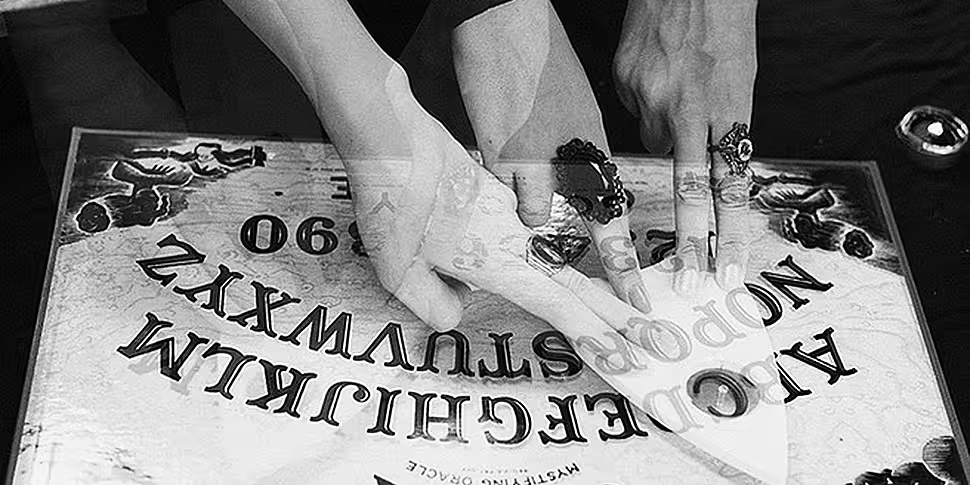We’ve seen it in the movies and on TV; “Stop it!” one of the pretty co-eds says to the other, their fingertips gently brushing the top of a moving tear-shaped counter with a window in the middle. “I’m not doing anything,” the other cries. They stare at each other, then back to the board, as it spells out of message from the spirits, unclear yet whether they’re friend or foe. The Ouija Board™, scaring the bejesus out of us since 1891.
The first adverts for the so-called ‘talking boards’ known as Ouija first appeared in February of that year, in a Pittsburgh newspaper. A piece of wood decorated with two arching rows of the alphabet, along with the numbers zero through nine, those wishing to receive a hex message from the great beyond were promised a magical wonder capable of answering questions “about the past, present, and future with marvelous [sic] accuracy.” Bridging the gap between the material and immaterial, the known and unknown, Ouija promised this world and the next, all for the price of $1.50.
It’s almost identical to the boards still sold in shops today, with its iconic planchette, the name given to the part that gets pushed around by forces physical or spiritual. And it is spiritualism, the Victorian obsession with the dead, that paved the way for one of America’s most innocent pastimes to take a demonic turn.
Spiritualism had been huge in Europe, but didn’t really take off in the US until the aftermath of the Civil War. At the time, the average lifespan was less than 50, with child mortality, complications from pregnancy, and war killing off almost everyone before they could reach a pensionable age. In 1848, three sisters, Leah, Kate, and Maggie Fox, became overnight sensations in Upstate New York when they claimed they were able to interpret the noises made by rattling spirits banging on the wall, and took their séances on tour, filling parlours across the state with words and omens from the dead.
The funny thing about contacting the dead was that it seen as a wholesome activity for all the family to enjoy. What’s more, it was compatible with a faithful life, with Saturday séances followed by Sunday services the next day. But as with any craze, spiritualism offered the chance to make money, and that’s when the Kennard Novelties Company stepped in to formalise how we get through to the other side – and what it costs to do so.
By the 1880s, the public was growing tired of waiting for the ethereal forces to get on with it. Sitting through a séance, waiting for the right bang at the right letter could be stultifying, with recitations of the alphabet on near endless loop. There was still a high demand for messages from beyond, but a growing impatience at the way they were coming.
Seeing reports of talking boards in newspapers, in 1890, a Baltimore man by the name of Charles Kennard pitched his idea for patenting their own version to a group of investors. None of them were particularly taken with the occult, but the omens were good that they’d spotted a gap in the market that could be exploited. None of them had a clue what to call their talking board, and so one of them, Elijah Bond, turned to his sister-in-law, presenting her as a “strong medium” of some renown. If they couldn’t think of a name, why not just ask the board itself?
And that’s where the name Ouija comes from; it is not, as most people with even the most basic smattering of French or German believe, a compound of Oui and Ja. Yes, yes? No, no. The board chose its own name, with Mrs Helen Peters, medium at large, calling out the letters O, U, I, J, A. When they asked the board what this meant, it told them “Good luck.” At least that’s the story.
Picking a name wouldn’t prove half as tricky as filing the patent. Elijah Bond, an attorney by profession, knew that they would have to prove the board could work to the clerk at the patent office if Kennard Novelty was going to secure the rights to silencing any other talking board. How they did it remains something of a mystery, but the legend says the gentleman turned up at the Baltimore office on February 10th, 1891. Sitting down in front of the clerk, they told the man that they board would be able to tell them his name, a fact unknown to them, as far as he was aware. Whether or not it was known to patent attorney Elijah Bond is the subject of much debate, but sufficed to say, after communion with some knowledgeable spirits, his name was spelled, and Ouija was written into copyright. Good luck, indeed.
The board was an instant success, quickly earning its way into almost every American home. Under the strict moral expectations of Victorian society, it proved to be an incredibly popular date-night activity between suitors, before the concept even existed. The instructions on the box suggested Ouija worked best when operated by a man and woman. Facing each other, in flickering candlelight, almost touching, convening with the spirits became such an everyday American pastime that Norman Rockwell, the artist famous for documenting Americana itself, even painted an image of a young couple touching knees, a talking board spread between them.

Norman Rockwell's Ouija creation [Wikipedia Commons]
And a fun-for-all-the-family activity it remained... until 1973. While there were a handful of stories of murders and mishaps associated with Ouija spirits throughout the 20th century, it really wasn’t until the movie The Exorcist was released, showing how playing by yourself could open the gates of hell, leading to demonic possession in all its pea-soup peril, and an Oscar nomination for Linda Blair.
William Friedkin’s movie, banned in Ireland until 1998, changed perceptions of the Ouija board overnight, with religious groups rounding on it as a tool of Satan. This myth continues today, with conservative Christian groups denouncing the board and planchette from time to time, even burning them along with copies of Harry Potter.
Last year, Hasbro, which now owns Parker Brothers and the rights to the board, poured money into a new feature film inspired by the demonic shenanigans of Ouija, aptly enough called Ouija. A by-the-numbers chiller, the movie received a cool reception from the critics and underperformed at the box office. A sequel, that presumably only the investors and spirits on the other side wanted, is in development.
And so Ouija lives on. For more than a century it's been bringing people together, in this world and the next. Just remember not to play with it on your own. After all, you never know who, or what, you'll be playing with...









